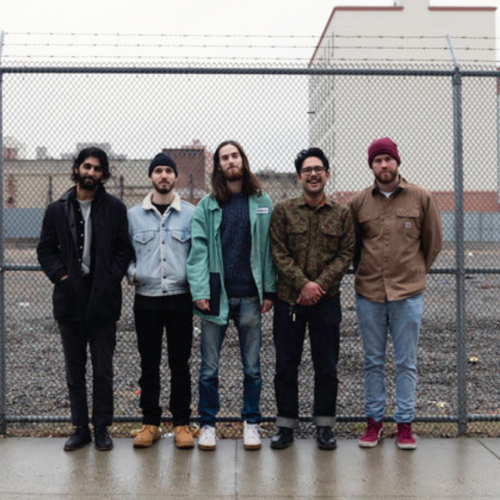You can never have enough happy melodies in the world. Glom’s new track, “Tell Me Who to Be,” encompasses positive energy and catchy lyrics, creating a beautiful little bop that’s the perfect background music for these last few winter months. The song’s retro sparkle is getting us ready for the warmer spring and summer times, and I’m all here for it!
With a song like “Tell Me Who to Be,” the elusive lyrics can act as a catalyst for the listeners’ imagination. The song’s story is able to be reinvented and relate to a variety of experiences in the listener’s life. It’s as if the song’s title- “Tell Me Who to Be,” cleverly hints at its own holistic interchangeableness. The ability of a song to tell multiple stories- depending on an individual’s mood or perspective- is the mark of a wonderfully brilliant piece of art.
Combined with the right lyrics and melody, a song can transport you to a distant memory, a yearning dream, or a fantastical future. The power of musical consilience is a magical act; “Tell Me Who to Be” is so delightfully crafted to be the soundtrack for a myriad of stories. Glom, a relatively newborn band, though the bandmates have been playing together for years, has fashioned a lovely little gem of a song. Interviewing them, I could tell right away they’re pretty down-to-earth, and it shows in this song.
Simple yet aesthetically satisfying, “Tell Me Who to Be” will have your head boppin’ to its feel good, nitty-gritty beat before you’ve even had your morning cup of coffee.
Glom’s vibe is an ideal contemporary mix of 80’s pop with a grungy 90’s edge. They believe in their sound- and I’m all for it. They take inspiration from a plethora of both new and older bands. I love finding out musicians’ favorite music, because it really shows what motivates them to create. I especially love when a band has an eclectic taste in music- and Glom certainly does! Take a listen to their song, “Tell Me Who to Be,” and then read on to find out what musical acts inspired their sound, how “Tell Me Who to Be” came about, and much more!
When and why did you guys decide to form a band?
Sean: Peter, Jonathan, Sahil, and I have been playing in bands together since early high school. They were cover bands for the most part, ranging from playing MGMT songs to an all-out Beatles cover band. When we all split up for college, we stayed friends and all had our own things going on musically. Peter and I wrote and recorded our first original song together in 2014 when we were on break from school, and 3 years after that we decided to see if we could write more. Then 2018 happened and we solidified the sound of Glom, finally completing the line- up with Johan, on keys and tamb, whom I knew from another band the two of us were in.
How would you describe the vibe of your band?
Sean: Recently, I have been very enamored with Bruce Springsteen and 80’s pop music in general. I wanted to combine the 80’s pop music atmosphere with the edge and songwriting sensibilities of 90’s alternative music, and I feel like that brings us to what Glom represents.
How has the band’s musical style evolved?
Peter: Sean and I have been playing music together in different contexts for quite some time now, but it’s funny, the whole Glom project stemmed from this Black Keys-esque debatably pushing southern rock song with a catchy riff that Sean and I wrote like 5 years ago and really liked. When we started writing songs together again in 2017, we tried to sculpt our sound around that song, and could not even come close. It was many months of constant collaboration, and some solidly bad songs, Sean suddenly wrote five songs that became the foundation of the album, and which have very little to do with that original song we liked so much.
When we demoed those, we thought we had found a pretty cool unique sound that was on the grungy shoegazy lo-fi end of the spectrum, but it was our good friend and producer Sahil Ansari who took the songs to the next level from a production perspective— he had an awesome vision for where the sound could go, so a lot of his influence is all over the album. Looking back, it was a totally unexpected but very fun process.
Who are some of your musical influences?
Sean: Peter and I bonded over our mutual love and respect for the Beatles and Nirvana, but other than that I’d say my biggest influences are the typical ones (for the type of music we play): The Smiths, Bruce Springsteen, My Bloody Valentine, Sonic Youth, etc. But there are definitely a few recent artists that inspire me as well like Jessica Lea Mayfield, the War on Drugs, and the first Yuck album.
Peter: This list is in no particular order but Tame Impala, Jeff Buckley, The Strokes, Chairlift, MGMT, Father John Misty, Nirvana, Weezer, Sam Cooke, Elliott Smith, Kendrick Lamar, and the Beatles.
Do you have any non-musical influences that inspire your music?
Sean: To be completely honest, I am extremely influenced by John Mayer’s outfit choices. I also used to be heavily into skateboarding and skate culture, so that definitely still inspires me daily. Wes Anderson’s The Royal Tenenbaums and Rushmore also play a big role in how I personally carry myself and see Glom presenting itself.
Peter: A little book called A Course in Miracles.
If you could collaborate with any musician(s)- living or dead- who would it be?
Sean: I would love to collaborate with John Lennon– he’s probably my biggest musical hero. I think it’d also be pretty fun to play with My Bloody Valentine, Kim Gordon, or Bruce. Collaboration kinda stresses me out, because what if my heroes don’t add up to the picture I created of them in my head? I should probably stay away from the people I consider heroes.
Peter: I would say I would bring back Jeff Buckley for my big celebrity collab, and then respectfully remove myself from the picture and let him write another album on his own.
What’s been your fondest memory of performing onstage?
Peter: Unfortunately my fondest memories of performing onstage right now are all in high school, or in a cappella groups, neither of which I would like to comment on at this time. One of my goals with Glom is to replace all of my memories of singing a cappella with new memories of singing in a real music group.
What kind of message do you hope to convey to your audience?
Peter: I don’t think we have a concise message for anyone, at least right now. I think it was one of the members of Sonic Youth said something like “people pay to see people believe in themselves,” referring to fans paying to see shows. I think that’s true, and I think that anyone who is involved in a craft like music, by doing it well, can serve as an inspiration to others to not only do what they love but to do it well while they’re at it. We’re definitely doing what we love, now just gotta figure out the doing it well part.
What’s your favorite part about creating and performing music?
Sean: I love having the ability to free my mind’s caged up thoughts I would have trouble expressing otherwise. It might be cliche to say, but I’ve always had a hard time expressing my emotions via speech, so writing and performing music provides that outlet for me.
What’s been your biggest challenge in your music career so far?
Sean: The biggest challenge in my music career is having a career in music.
Peter: To be flat out entirely honest in my response to this question, my personal biggest challenge has been the process of “finding my voice” in both the literal and figurative senses. Up until now, writing and performing music has been a pretty hazy fantasy life of which I had only considered the most basic aspects, i.e. what to do with my hands while singing. As I write more music and am forced to write lyrics to accompany it, I’m asking myself more and more what it is that I actually want to be saying, and how it is I can convey that with my voice. It seems like to some people that comes pretty naturally but not to this guy.
What does the creative process look like for you?
Sean: When I get an idea, I like to record a quick voice memo of it. And then after it’s been in my head for the day, I try to block it out and expand on the guitar then get some basic lyrics for it, and eventually record a rough demo of the idea. I’ll play the demo on loop the next day or two, then sit back down and finalize the words and melody. When it comes time to make a real demo of a song, I’ll eat at the indian buffet, then record with the natural daze that overeating gives. I also like to have the TV on as background noise.
Where’s your favorite place to write songs?
Sean: I like to sit in this chair that I have in my room, it’s green, squeaky, and old but it’s close enough to my bed that I can put my feet up.
Peter: I’m usually in a pretty dark place when I sit down with a guitar and a song worth sharing with anyone comes out.
How have your life experiences shaped your music?
Sean: After high school, I joined a regional band that toured the east coast and I learned a lot about what it means to be in a working band and how to be productive musically despite being away from my comfort zone. Being away from home for a decent chunk of the year was very liberating at first, but then the realities of being on the road started to be very mentally taxing. However, I learned a lot about myself on those long trips and was able to hone my skills musically and creatively for the 5 years I was involved with the project.
How did you guys write “Tell Me Who to Be?” Did you all have a piece to contribute, or were one of you individually inspired to write it? How do you normally write songs as a band?
Sean: I had the riff for it for a few months, but kinda put it on the shelf in my mind until the day I went to a street fair. Great day. Woke up, bought a BOSS CE-2 Waza and then met up with my friend Campbell. We get there, nothing but great vibes. Somehow or another the phrase “tell me who to be” seeped into my head. When I got home, I polished the riff, completed the song, and recorded the demo to send to the rest of the crew. That song ultimately shaped the fully actualized vision of what Glom sounds like, so that day was very important to me.
I wrote the riff a few months before, with the intention of using it for a project with another friend, but couldn’t figure out how to transform the barebones riff into a full song. After collecting some dust on my mental shelf, the idea for the full song came to me after the day at a street fair where I purchased a chorus pedal. “Tell Me Who to Be” took shape almost immediately after I got home. The original demo of “Tell Me Who to Be” was pretty crucial because it laid the blueprint for the actualized version of Glom’s overall vibe and sound.
Do you have any advice for aspiring artists and musicians?
Sean: Have your instrument in your hands as much as you can. When I was learning to play guitar as a young child, I had the guitar in my hands from when I got home from school to when I went to bed. The quicker the instrument becomes an extension of your body, the channel for creativity will open and flow
Peter: As far as advice goes I can only really comment on my experience with the creative process, being so far an entirely unaccomplished professional musician. An important lesson for me was that the process is, as much as you think you have control over it, pretty out of your hands. You can set up your songwriting shrine, light a couple candles, say a prayer and wait for a divinely inspired melody to be bestowed upon you, get nothing, and then be in the subway en route to a colonoscopy when your next song just flutters faintly and unexpectedly into your consciousness. If you want to write music, definitely put yourself in music-writing situations, but also be vigilant for what’s floating around in your head waiting to come out at any moment.
What’s next for Glom in the future?
Sean: Write better songs, have more fun, record.







